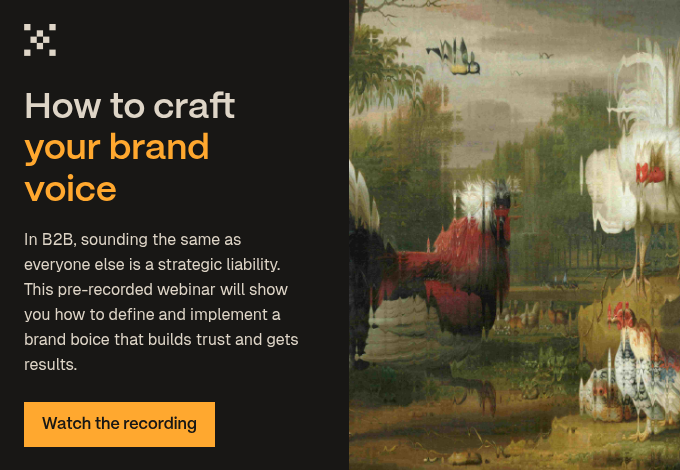Inbound marketing is about answering questions and connecting people to the right information. It’s targeted and – ideally – not annoying. Unlike outbound marketers, we’re here to inform, educate, entertain, inspire and solve problems. It’s not sell, sell, sell.
‘Inbound content marketing is the worst form of marketing,’ to misquote Churchill, ‘apart from all the others.’ Although, of course we would say that because it’s what we do at Articulate.
It’s not just us, though! Research shows that inbound content marketing is cost-effective. HubSpot reckons that it costs 61 percent less per lead than traditional techniques. That’s all well and good, but what exactly is it?
In the time since this article was originally published, we have split this content between several articles, so if you’d like to read our original comprehensive guide altogether, download it using this form:
Inbound marketing vs content marketing
Some people differentiate between inbound and content marketing. Usually, these are the kind of people who gleefully point out the one spelling mistake in a blog, as if that invalidates the message of the whole piece. We’re looking at you, comments section.
If you absolutely must put neat boxes around these terms, think of it like this: all content marketing is inbound, but not all inbound marketing is content marketing. Inbound is the overarching term for attracting and converting site visitors into leads. Although content marketing is a big part of that, other things, like technical SEO, are part of inbound but are not exactly ‘content.’
We tend to use ‘inbound marketing’, ‘content marketing’ and ‘inbound content marketing’ interchangeably. So far, no harm has come of it.
The inbound marketing framework
There are three steps to creating content for inbound marketing:
Step one: create
Create consistent, high quality, engaging, and educational content that solves your personas' (your audience) problems. If the content is targeted, your ideal leads will find this content through search engines or social media and, in turn, visit your website.
Step two: convert
Convert those visitors into leads by asking them to fill in a contact form in return for free content. If the content is of a high enough quality, they will be satisfied with this exchange and will look to answer more of their questions on your website.
Step three: nurture
Nurturing those leads into more qualified leads via email, social media and more content. Once a good deal of trust has been established between the lead and the business, they will be far more likely to show interest in your product or service when they receive a call from your salespeople.
This process allows you to not only outflank your competition by positioning yourself as a thought leader in your industry, but also to take control of your customers' research and evaluation process. You attract more traffic, create more leads and build trust between you and your audience (or your client’s audience), which is crucial. After all, when was the last time you bought something from someone you didn't trust?
Why inbound marketing matters
CEOs have always kept a close eye on sales, but their attitudes about how to target their audiences are changing. What’s new is their use of words like ‘audience’, ‘content’ and ‘proving ROI’, which means they’re all looking towards the marketing department now. If you’re a business owner and you aren’t opening the marketing team’s monthly analytics reports, then get on the bandwagon and dive into the data.
Inbound marketing helps you engage with people much earlier in the sales cycle. And, it allows you to extend the sales cycle beyond the actual purchase decision. The right content can empower your customers to get more from your products. It also encourages repeat business. If you can delight customers as well as close leads, you can turn them into advocates. Word-of-mouth endorsement is a very powerful sales tool.
Think about your own experience being sold to. Would you prefer a noisy intrusion into your day or useful, relevant information when you wanted it? What would you think of the companies that used these different strategies?
Again, the evidence supports the argument for inbound. Intrusion fails spectacularly.
If you use online advertising, you already know the pain of keyword competition, rising costs and falling conversion rates. Worse, you practically need a PhD in Google Adwords to run a campaign. It’s the gift that doesn’t keep giving, unless you are clever enough to use it as part of your inbound strategy. Instead:
- Go to where people are – social media, search engines etc.
- Talk about things that matter to them.
- Use their language, not yours.
- Become a trusted advisor.
With inbound marketing, the traditional AIDA model of the sales funnel gives way to the Attract-Convert-Close-Delight model (thanks, Hubspot).
.jpg?width=1000&height=456&name=image%20(2).jpg)
Research shows that inbound content marketing helps at every stage of the sales cycle. Here’s how it works:
Attract
Inbound marketing will deliver 54 percent more leads into your funnel. Long-form content such as ebooks are particularly effective at attracting potential leads as they provide the most value. Furthermore, calls to action promoting them get almost twice the click-through rate as emails promoting webinars. Blogs are also an essential element part of enticing people to your site, with B2B companies that blog generating 67 percent more leads and B2C companies generating 88 percent more leads.
Convert
Landing pages with persona-targeted copy are a smart way to convert leads into customers. And the more you have, the better. Businesses with 31 to 40 landing pages get seven times more leads than those with only one to five landing pages.
Close
Lead-nurturing emails and a drip feed of relevant content helps to convince leads to buy. In fact, nurtured leads make 47 percent larger purchases than non-nurtured leads. What’s more, relevant emails drive 18 times more revenue than broadcast emails.
Delight
Social media monitoring and how-to guides can turn customers from ‘users’ into ‘champions’. These evangelists will hopefully be satisfied enough with your services to offer reviews or feedback for case studies. And, of course, they may even become long-term retainer clients.
How to do inbound marketing well
Successful inbound marketing means spending the time to give your audience content that they want to read, listen to or watch for free, before asking them to buy.
But you can't crank the reel in too quick – you'll lose them and they won't come back. so, if a visitor downloads their first eBook or white paper, don't immediately bombard them with emails about how they should contact your sales department and what products of yours they should buy. That’s likely to turn people off. Instead, you might simply suggest another couple of pieces of useful, relevant content via email.
It's about nurturing the relationship before and after the sale to build trust, delight your customers and encourage repeat business, so consistent, high-quality content that maps to each stage of the sales cycle – awareness, evaluation, purchase, post-purchase – is key.
This isn't a one-off sale; it's a long-term relationship. And, it's a long-term relationship that pays dividends.
Inbound content marketing is measurable, meaning you can sharpen your tactics as you go, giving you more control over your sales and marketing spend.
But, more than that, it has a cumulative effect that makes it more cost-effective over time.
A study by Kapost and Eloqua found that content marketing delivered over three times more leads than paid search efforts over a period of 36 months. Additionally, their cost-per-lead reduced from $111.11 from paid search to $32.25 for content marketing.
Once you create the content, it's yours and it's there forever. It gives you a back catalogue of useful material for your audience to read and share, and a growing keyword footprint that boosts your search rankings. You'll get a steady trickle of sales-ready leads rather than a flurry of unsuspecting strangers that contribute to nothing more than vanity metrics.
Create great content and you'll be patching up the leaky funnel and nurturing a more receptive audience that's ready to talk. Done right, it creates a smoother sales process and a bigger boost to business growth.
One important caveat: inbound is certain cheaper than outbound marketing, BUT…
…Cheap content will kill your search visibility
Content is important for SEO, right? Yes. The more content the better, right? Yes. But not just any content. And not at any price.
The temptation to trim costs to fit a limited budget is understandable (if short-sighted). Times are tough, yada yada. You’re either investing enough money, or you’re not. If you’re not, you might as well not bother. So, make sure you pay your copywriters well, give your marketing team the resources they need to actually make a difference.
Take this example:
One company pays a content mill to write ‘keyword-optimised blog content’ at bulk rates because ‘it’s good for search engine optimisation’. They get a load of cobbled-together blogs that attract the attention of 50 people per blog, converting the odd one into a lead. But hey, they’re doing content marketing, right?
The other company, whose website gets comparative traffic, goes to an industry-experienced marketing agency. This agency provides them with data-driven insights into the best strategy for producing SEO-optimised content, with background work on copy length, tone-of-voice, personas (we’ll still get to that later), keyword research, and much more. This supports the creation of extremely targeted, thought-out content written by professional copywriters.
And, better still, these pieces of quality content drive thousands of visitors to the site every month.
It’s about creating some of the best answers on the internet, not a bunch of answers that sit on page four or five of Google. What good does that do? Cheap content could be killing your brand, destroying your search engine rankings and annoying your customers.
Google is very clear about the importance of good quality content. In its best practices guidelines it says:
- Create helpful, reliable, people-first content.
- Use words that people would use to look for your content, and place those words in prominent locations on the page, such as the title and main heading of a page, and other descriptive locations such as alt text and link text.
- Make your links crawlable so that Google can find other pages on your site via the links on your page.
- Tell people about your site. Be active in communities where you can tell like-minded people about your services and products that you mention on your site.
- If you have other content, such as images, videos, structured data, and JavaScript, make sure you're following those specific best practices so that we can understand those parts of your page too.
- Enhance how your site appears on Google Search by enabling features that make sense for your site.
- If you have content that shouldn't be found in search results or you want to opt out entirely, use the appropriate method for controlling how your content appears in Google Search.
More importantly, how likely is a cheap blog post to be a good showcase for your business’s products or services?
Website visitors – yourself included – have very finely-honed bullshit detectors. We form almost instant judgements about websites. Why? Put simply, we’re trained to spot typos, badly-written copy and waffle because there is simply so much of it about. On the other hand, we’re drawn to useful, relevant, authoritative, remarkable articles.
Research into readability by the Neilsen Norman Group shows that if we aren’t valuing copywriters and good content, then we’re missing out:
‘Content rules. It did ten years ago, and it does today. People don’t use things they don’t understand. Writing for the Web is still undervalued, and most sites spend too few resources refining the information they offer to users.’
How to cleverly invest in inbound content marketing
Here’s a note for business owners and CEOs: invest in inbound.
Naturally, invest wisely. Here are some tips on making the most out of your budget:
Hiring
Sometimes, you just have to bite the bullet and hire some new talent to plug a skills gap or enhance your business’s marketing efforts.
If you don't have the resources to take on someone full time, consider hiring freelancer copywriters with the specialisms you need to create the campaigns and content you want. Just be careful and pick the right people for the job. And give them a good brief. Please.
Outsourcing
What if you just can’t take anyone else on, or can’t devote any more time internally to marketing? Try outsourcing some of the work to a marketing agency. You might outsource a specific sort of content to the agency – say, blog writing, infographics or video – if you lack the skills internally. Or you might want to outsource entire campaigns/channel if you require an all-inclusive strategy that’ll create a bigger impact.
Marketing automation
Marketing automation software, like HubSpot, integrates your website with your blog, social media, search engine and email marketing. These tools use landing pages and CTAs to nurture leads more effectively and convert them into customers. Integrated analytics allow you to accurately measure the success and ROI of your marketing campaigns, as well as tweak them to improve conversions. Ultimately, this allows sales and marketing to work together more closely, setting and assessing goals based on hard data.
So, if the going gets tough for marketing, don't give up on your team. Identify what the problems are and start working on the short-term and long-term solutions. But on that outsourcing point – why should you consider using professional copywriters and marketers?
Copywriters are professional writers; they're specialists
Today’s customers aren’t waiting for companies to tell them what they need to know; they're doing the legwork and seeking out the information themselves online. This isn’t something to fear. This just means businesses will have to adapt by investing in a solid content marketing strategy. Marketing copywriters everywhere – rejoice! It’s your time to shine.
Inbound content marketing isn’t ‘arts and crafts’ anymore, if it ever was, in the same way that IT isn’t ‘fix my computer so I can get on with the real work’ – it’s a key part of the business strategy. Content marketing is the next generation of selling. So, reshuffle some of that budget and give the new kids on the block a try.
‘If you have budget to invest in your website, I would say, “hire someone to write for you.”’ – Rebecca Churt, HubSpot
We do have to make a stand somewhere, right? As an agency full of copywriters (I’ll be honest, a copywriter is writing this right now. I know, spooky), we believe in the power of our work. Professional copywriters help you cut through the noise. They write pithy, persuasive, remarkable content that resonates with your customers and drives up sales. That’s what makes this whole inbound effort really worth it.

 Posted by
Maddy Leslie
Posted by
Maddy Leslie
.jpg?width=1600&height=800&name=europeana-cguOW7oi5TM-unsplash%20(1).jpg)



.jpg?width=400&height=250&name=art-institute-of-chicago-pybByTGQ9zI-unsplash%201%20(1).jpg)
.webp?width=400&height=250&name=Frame%201%20(9).webp)

